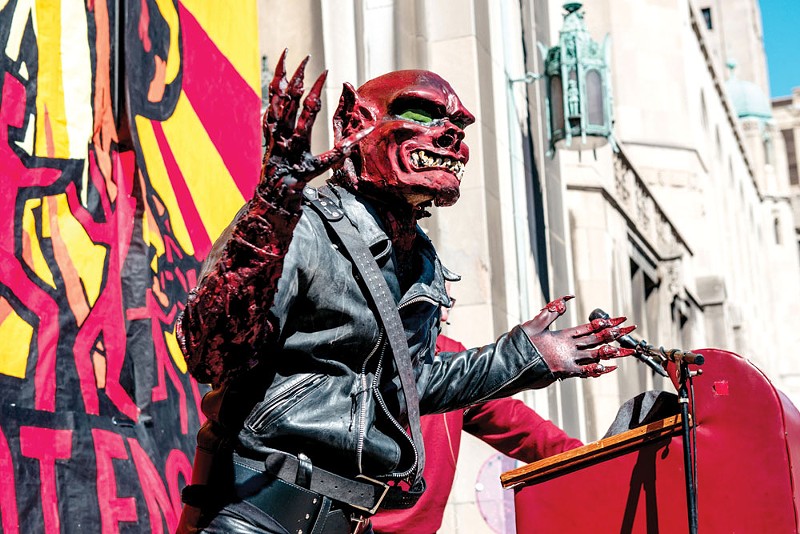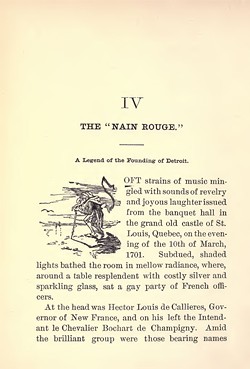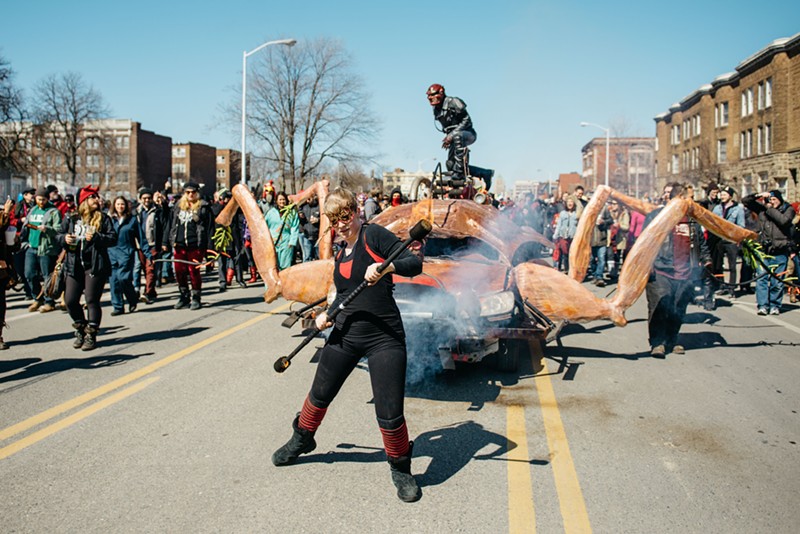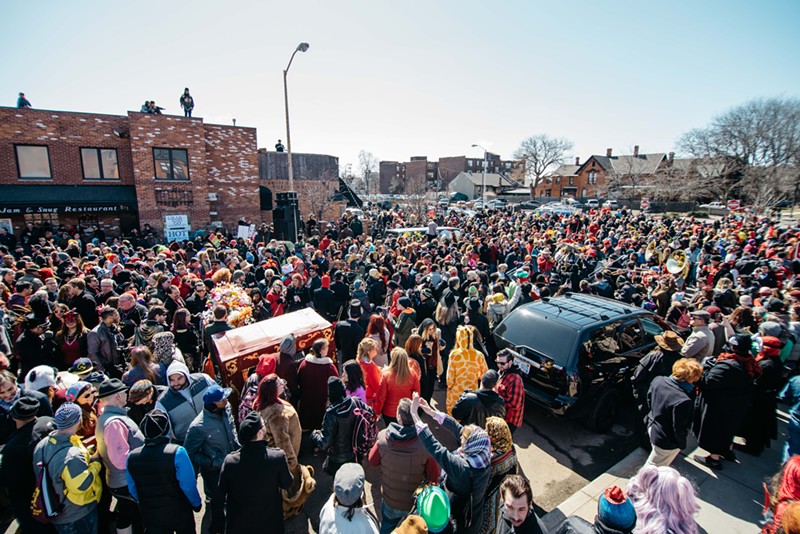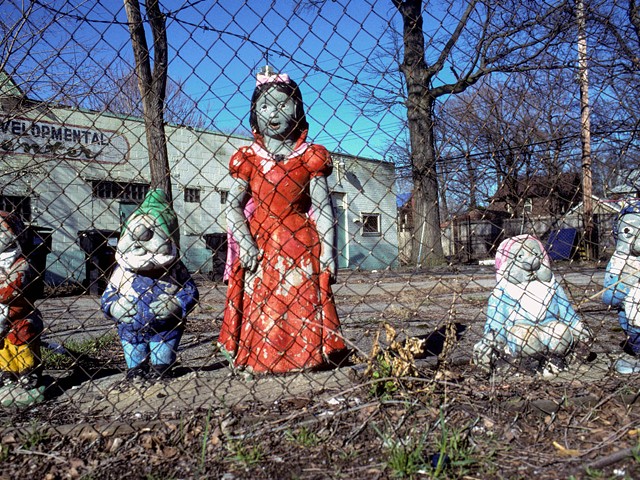It's springtime in Detroit, a city that has once again fallen, as has happened so many times throughout its history.
After decades of decay, a new generation has begun to repopulate the city's core, bringing with them strange new traditions. As they did the previous year, they gather in the city's historic Cass Corridor, clad in red and black disguises: masks and capes, wigs and tricorne hats. They arrive at the foot of the Masonic Temple, a towering monolith that is one of the few buildings left intact in the lower Corridor.
At the front of the procession is a devilish figure — the size of a grown man, with pointed ears and fangs and teeth, red skin, and dressed in tattered black leather — riding atop a chariot fashioned to resemble a giant cockroach.
The figure dismounts his chariot and ascends the stairway to the front of the Masonic Temple. A fire dancer twirls at the foot of a large banner depicting an apocalyptic mushroom cloud. Above it is the message, "Two Detroits is not enough." Below, "Detroit vs. Detroit vs. Detroit."
The red creature waves his claws, gazing out at the crowd that has assembled before him. "I am the legendary Nain Rouge of Detroit, the harbinger of doom," he bellows. "The living embodiment of everything that holds Detroit back, the red prince of persecution, Cadillac's folly, the annihilator of hope ... "
The attitude of the crowd suddenly changes, the air of merriment giving way to boos and jeering. The noise begins to drown out the Nain's speech, but before he is completely overwhelmed, he makes a promise:
"I'm going to tear this city apart!"
Meanwhile, unnoticed by most of the revelers, a man in a trenchcoat has been shouting back at the Nain. He's surrounded by several others, all holding hand-painted signs: "Stop Nain Shame," "Be Nice 2 Nain," "Don't Dread the Red."
As the Nain gets louder, the man in the trenchcoat and his supporters get louder too.
"This is a false Nain!"
"The real Nain is nice!"
"Your mask cannot cover your lies!"
This showdown has been hundreds of years in the making.
The legend of the Nain Rouge is said to go back to 1701, when Antoine de la Mothe Cadillac founded Detroit. The shortened — and oft-repeated — version of the tale states that Cadillac was attacked by the feared "Red Dwarf," who then cursed Cadillac and the city.
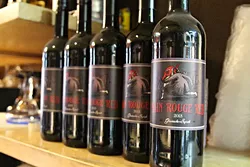
The folk tale has persisted on the periphery of Detroit culture, with the Nain said to appear before disaster strikes. According to legend, the Nain appeared right before 1763's Battle of Bloody Run, where around 60 British soldiers were killed in a thwarted attack against Chief Pontiac. The Nain was also said to have appeared before the infamous 1805 fire, which nearly destroyed the entire city.
Some say the dwarf could be seen before the 12th Street Riot in 1967. And as recently as 1976, it was reported that two DTE workers spotted what they thought was a child climbing a utility pole before a particularly brutal snowstorm crippled the city — possibly the most recent Nain sighting.
But it wasn't until the Marche du Nain Rouge parade began in 2010 that the Red Dwarf became more of a household name. Last year, Caliber Comics published Nain Rouge: The Red Legend, a graphic novel depiction of the tale. This year, Woodberry Wine is distributing Nain Rouge Red wine in Michigan, just in time for the Marche.
The organizers of the parade would have you believe that the Marche has been an uninterrupted Detroit tradition. "Supposedly, for 300 years, on the Sunday after the Vernal Equinox, Detroiters have celebrated liberation from the Nain Rouge, the fiendish embodiment of all that holds us back," the event's website says.
In reality, the origins of the Marche are well-documented, starting as a beer-fueled idea between then-Wayne State University law school students Francis Grunow and Joe Uhl.
"We were talking about how a place like New Orleans and Detroit have a lot of similarity, especially around their French heritage and founding, and how New Orleans has Mardi Gras and Detroit really doesn't," Grunow told Metro Times in 2014. But Grunow says he saw other possibilities for Detroit in the way Mardi Gras took on a symbolic meaning in New Orleans after Hurricane Katrina struck in 2005. "Mardi Gras was a big way for New Orleans to show it was healing or healthy again," he told us. "It was a tradition that was really cathartic."
Grunow and Uhl envisioned a new Mardis Gras type of event for Detroit, which would feature a parade of people dressed in disguises (so as not to be recognized by the Nain), "driving out" the Red Dwarf, ushering in a new season of change.
To their surprise, hundreds of people showed up the first year, with the event culminating in burning an effigy of the Nain. The next year, even more people showed up.
In 2015, it was reported some 5,000 attended the parade.
Tracking down the man in the trenchcoat is easy. He's John E.L. Tenney, who is known around town as a self-described "anomalistic researcher." He agrees to meet us in Royal Oak, the city where he unsuccessfully ran for mayor in 2001. We meet at the Café du Marquis, which we decide upon solely based on its French-sounding name.
In the '90s, Tenney worked as a researcher for the popular documentary TV show Unsolved Mysteries, contributing to episodes about paranormal phenomena. (The trenchcoat, he tells us, is his homage to the show's ominous host, Robert Stack.) Today, Tenney travels around the world giving his "Weird Lectures" on everything from Bigfoot to UFOs to conspiracy theories.
At the parade, Tenney might come off as an affable, ironic pro-Nain prankster. At first it can be hard to tell if he's serious or joking. "As a lecturer, I understand that confronting people and being harsh turns people away," he says. "People are more willing to listen if you're having fun with it."
He says when he first started protesting the Marche, he was a lone interloper. But last year, he amassed a group of about 15 protesters.

Cloaked under the cover of the coffee house's blaring techno music, Tenney lights up a cigarette. We have to get this out of the way: Does Tenney actually believe in the existence of the Nain Rouge as a paranormal being?
He pauses, taking a drag of his cigarette. "That's an interesting question," he says. "If it exists in your mind or your imagination, it exists as much as anything else does." (He describes the Nain as a "nature spirit," or an "understanding of nature" — "for lack of a better word.")
Metaphysics aside, Tenney accuses the Marche of getting some basic facts about the Nain Rouge wrong. He shares with us the earliest recorded version of the tale, chronicled in Legends of Le Détroit by Marie Caroline Watson Hamlin.
As a researcher, Tenney says he's driven by what he sees as the death of storytelling in the Internet age, which has seen accuracy and nuance replaced by soundbites, three-minute YouTube clips, and memes. "I think as we've seen with the way the Internet has developed, people are losing their ability for storytelling, when storytelling is historically how we've always passed information down to each other," he says.
The full tale, scanned from the original book, is available for download on Tenney's website, nainrouge.weirdlectures.com. "I've had those sample pages about the Nain on my website for seven years," he says. "Anyone can look at them. But nobody wants to read it. It's too many words."
There are no records indicating the legend of the Nain Rouge actually goes back to the time of Cadillac. Hamlin's Legends of Le Détroit wasn't published until 1883, some 180 years after Cadillac's run-in is alleged to have occurred.
Hamlin had her own motives for publishing the story. A proud descendant of the city's early French settlers, by her time, Detroit was an American city — its French-speaking inhabitants almost entirely replaced by English. Much like Grunow, Hamlin was using the legend of the Nain to reaffirm her city's identity and to preserve its French heritage.
"Originally brought from their cradle in Normandy, they are still tenderly cherished in the homes of the old families of Norman descent settled along 'le Detroit,'" she writes of the tales she collected in the book's preface. "It has been my good fortune to hear many of them from loving though aged lips of ancestors whose memories extend back into the last century."
An abridged version of her legend of the Nain Rouge follows (emphasis ours):
The tale begins in 1701 at a party held by the governor of New France in honor of Cadillac, who had just been given permission to build a fort. Suddenly, an old fortune teller appears at the door.
She is "Mère Minique, La Sorcière," described as "a woman of unusual height, a dark, swarthy complexion, restless, glittering eyes, strangely fashioned garments yet in harmony with her face." On her left shoulder sits a black cat that occasionally licks her ear — "the more superstitious thought it (was) the devil giving information," Hamlin writes.
At last she comes to skeptical Cadillac. She says he "will found a great city which one day will have more inhabitants than New France now possesses; many children will nestle around your fireside."
Intrigued, Cadillac asks her to continue. But then his fortune changes. "The policy you intend pursuing in selling liquor to the savages, contrary to the advice of the Jesuits, will cause you much trouble and be the cause of your ruin," she says. Cadillac was not fond of the Jesuits, a Catholic brotherhood that strongly opposed to the sale of brandy to the Native tribes, an immense source of revenue for him.
The sorceress' prophecy continues: "In years to come your colony will be the scene of strife and bloodshed, the Indians will be treacherous, the hated English will struggle for its possession, but under a new flag it will reach a height of prosperity which you never in your wildest dreams pictured."
The sorceress issues a final warning: "Appease the Nain Rouge," she says. "Beware of offending him. Should you be thus unfortunate not a vestige of your inheritance will be given to your heirs. Your name will be scarcely known in the city you founded." A footnote reiterates that the Nain should be respected, describing it as "the demon of the Strait," and "most malignant, if offended, but capable of being appeased by flattery."
Six years pass. Cadillac's colony was prosperous, but all was not well. Cadillac and his wife go for a stroll, where he catches a fragment of a conversation between two passers-by complaining about conditions for the poor. One says his wife recently saw "le petit homme Rouge."
Suddenly, the Nain appears — "very red in the face, with a bright, glistening eye; instead of burning, it froze, instead of possessing depth emitted a cold gleam like the reflection from a polished surface, bewildering and dazzling all who came within its focus," Hamlin writes. "A grinning mouth displaying sharp, pointed teeth, completed this strange face."
Ignoring the warning of the sorceress, Cadillac strikes the Nain with his cane, and the creature vanishes. "You have offended him," says a voice. "Your impetuosity will bring you and yours to ruin. You were told to coax him — to beware of annoying this demon — and in your ungovernable temper you do just otherwise. Misfortune will soon be our portion."
The rest, of course, is history. "Since then he has never reappeared, having, it is to be hoped, accomplished his mission," Hamlin writes. "But the tradition still lingers among the old inhabitants that should misfortune ever threaten the bonnie City of the Straits, the Nain Rouge will again appear to give the signal of warning."
In French folklore, there are traditions of small beings called lutins. Europe is rich with tales of sprites, hobgoblins, elves, leprechauns, and countless other small and occasionally rascally supernatural beings.
The French brought the idea of lutins with them to the New World. According to an 1892 issue of The Journal of American Folklore, "In the French-speaking parishes of the province of Quebec, the lutins are considered as mischievous, fun-loving little spirits, which may be protecting or annoying household gods or demons, according to the treatment that they receive from the inmates of the house where they have chosen to dwell."
The passage also says that lutins have the ability to shapeshift, and can take the form of a domestic pet. Lutins in the French-Canadian tradition are especially associated with black cats. "Black cats have always had a rather suspicious reputation as associates of sorceresses and witches, but it is singular that among our peasants they are regarded as protecting goblins, and that no one would think of parting with them, chasing them away, or ill-treating them in any manner," according to the journal.
But a uniquely Detroit aspect of Hamlin's tale is the Nain's proximity to the Native tribes. Not just a protector of the peasant class, in Hamlin's tale the Red Dwarf seems to be on the side of people who have been described as red-skinned.
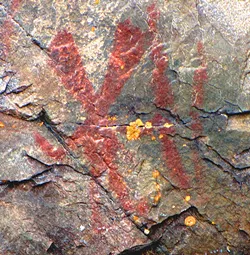
Could the legend of the Nain actually have Native American origins? Tenney thinks so. He points out that many Algonquian tribes have folkloric traditions of figures that resemble the Nain. A popular folkloric figure is Nanabozho (also known as Nanabush), a benevolent trickster hero who could shapeshift into any form, but was often associated with rabbits and referred to as the "Great Hare." A pictograph found painted in Bon Echo Provincial Park, Ontario, depicts Nanabozho as a red rabbit-like figure.
Kate Grandjean, an assistant professor at Wellesley College who specializes in early American and Native American history, has been researching the history of the legend of the Nain Rouge for a forthcoming book. "My personal feeling is it's really not quite as simple as just European colonists appropriating some Native American spirit," she says. "I think, and it seems to be demonstrable in the historical record, that the Nain that we know in Detroit today probably has both French and Native traditions sort of wrapped up in it."
For the woodsmen of New France, maintaining a friendly relationship with local tribes was essential for the fur trade, and early French settlers made great efforts to integrate. "The French definitely developed relationships with the Indians that were much more cooperative than the English," Grandjean says. "It's not outlandish or crazy to think that the traditions of different people would have somehow come down through time in a blended way."
At the Café du Marquis, Tenney lights up another cigarette. He says he's been struggling to get the story of the Nain Rouge right for years. In the late '90s, WDIV consulted him for a special on Michigan folk tales. That's when he told them about the then-little-known legend.
WDIV's final segment aired in 1999. But when Tenney saw the final version, he was mortified. "It was maybe a 45-second piece in an hourlong special. But they dressed someone up in a cloak and put huge red glowing eyes on it," he says. "Instead of talking about it being a herald or a harbinger of things to come, it was, 'He was causing these things to come.'"
Tenney was so disappointed in the segment he demanded his name be removed from the final product. That's perhaps why the recent revival of the Nain tale hits a sore spot for him.
He's also put off by the overwhelmingly negative tone of the Marche. In past years, Tenney says people have pushed him, ripping the signs and fliers out of hands — reasoning that if he is pro-Nain, then he must be anti-Detroit.
Tenney chalks it up to a "byproduct of alcohol and misinformation." But it's not just adults who he sees whipped up into anti-Nain furor.
"People are bringing their kids to it. I saw a lot more children last year than I saw before," he says. "It's a family-fun event — except it has this underlying message of hatred." Tenney says he saw a child "screaming viscerally at the front steps of the Masonic Temple" at the parade's version of the Nain. "This 8-year-old, like, 'Get out of here, I hate you!'" he says. "I was like, this is kind of horrible."
As far as Tenney can see, there's a simple solution: Recast the Nain as the good guy, and appease him, just like the legend says.
Instead of acting like Cadillac, Tenney thinks Detroiters should identify more with the Nain. "The fact is, we have an ancient helper," he says. "You can tell people, 'Let's be like this ancient helper. Let's watch out for each other. Let's make sure nothing bad happens to our city. When something bad is happening, we'll tell each other.' All of a sudden you give people hope. They're not blaming something — they're taking responsibility for their community. It has so many possibilities in that direction."
Tenney takes another drag of his cigarette, and once again waxes metaphysical.
He talks of the concept of the three deaths: The "first death" is when your body ceases to function. The "second death" is when your body decays back into the earth.
"The 'third death' is the final death, which is sometime in the indeterminate future — the last time time someone says our name out loud," he says. "So as storytellers, we keep each other alive. I feel badly when it comes to something like the Nain which persists — but in a disfigured, horrible state."
Marche du Nain Rouge co-founder Francis Grunow says he can't remember the first time he learned of the legend. As a teenager, Grunow loved to pore over the Burton Historical Collection. "I really fell in love with research, and libraries, and books," he says. "I spent hours and hours at the Detroit Public Library. I would spend the whole weekend there." Grunow's love of history led to him working as an intern at Preservation Detroit. Much later, he became its executive director.
Grunow's father is from Dearborn, and his mother is from Scotland. They met in Africa, while Grunow's father was in Catholic seminary. He abandoned his plans for priesthood after meeting her, returning to the Detroit area to raise his family. Grunow grew up in Minock Park near Rosedale Park on the city's west side, graduating high school in 1992.
After high school, Grunow moved to New York City, where he lived for nearly a decade. But he says he would still research his hometown for fun. He thinks it's likely he first learned about the Nain Rouge around that time.
"When a story like the Nain Rouge comes up, what I find fascinating about it is that it alludes to a time long before us," Grunow says. "These things resonate in weird ways. Is it something we can use today in a positive way? That's the point of the parade."
Grunow knows the parade has been perceived as negative by some critics, and says the event has evolved over the years in response. One example was the burning of the Nain Rouge effigy. He admits he initially pushed back, citing England's Guy Fawkes Day and Nevada's Burning Man festival. Ultimately the other organizers decided to ditch it, and Grunow ceded.
"I don't like dwelling on why we did or didn't do it," he says. "We just thought it would have better appeal, a wider audience over time if we changed it."
He says part of the appeal of the event is that it changes slightly every year. Previous Marches have poked fun at current events in Detroit, like the city's Chapter 9 bankruptcy filing in 2013. This year, the parade will have a Star Wars theme.
We convey Tenney's complaints about the parade: that in Hamlin's tale, the fortune teller warns Cadillac to appease the Nain Rouge. Grunow's brow furrows. "If we had a celebration of the Nain Rouge as being a good character, it would be a whole different thing," he says. "It wouldn't be a catharsis in the same way."
We ask about the other creative liberties the Marche organizers have taken, such as why their Nain isn't a dwarf. Grunow says it's simply because they don't have access to a little person to play the role. (As for the Mad Max view of a Nain that rides on top of a mechanical cockroach, Grunow responds, "Because he's badass." The cockroach, he says, is a symbol of the "resilient cockroach that survives the nuclear apocalypse.")
At a certain point, Grunow grows weary of spending so much energy debating a make-believe figure. "I'd much rather be talking about regional government, or transportation, or water," he says. His background, he says, is in urban planning — not art. But he thinks the most important thing the Marche does is that it gives Detroiters a chance to vent frustrations about real issues and to laugh. "Detroit takes itself far too seriously," he says. "As bad as our problems are, and they are many and profound, we do not laugh at ourselves very well."
This year, the parade is a bigger priority for Grunow. For the first time, he's being paid on retainer to organize it by Midtown Detroit Inc., which is providing matching funds up to $30,000 to pay for the parade. New this year, organizers have started a crowdfunding campaign to give $1,000 to different neighborhoods to make floats. Grunow says he hopes the neighborhoods use the money to make floats about issues in their communities, such as the group from Indian Village that showed up dressed like streetlight poles last year to raise awareness of their neighborhood's broken lights.
Funding comes from more than 30 businesses and foundations, and will be used to pay for a police presence, a sound system, insurance, and portable toilets. Grunow says that this year, organizers will offer a variety of official Nain Rouge merchandise, including coloring books.
Janet Langlois is a retired associate professor from Wayne State University's folklore department. She has a particular interest in the Nain, due in part to her French ancestry. Of all the people interviewed for this story, Langlois is the only one who pronounces the word "Nain" as "nan" — everyone else pronounces it as rhyming with "pain."
Even though the Marche takes place right outside of her school's campus, Langlois was unaware of the tradition until we asked her about it: She stopped teaching in 2010 to take medical leave, and officially retired last year. She's pleasantly surprised to learn the legend has taken on a new life.
"That's wonderful!" she says. "I would put that in one long line of traditions of the Red Dwarf."
We tell her about the man in the trenchcoat, and those who say the Marche is a misinterpretation of the original tale. This doesn't surprise her.
"You have every right to interpret any of these stories as you wish, because everybody does," she says. "And of course there's never one story or one interpretation. Depending on who is using the story, it may have different interpretations at different times."
Langlois says folklore is by definition an "unofficial" account, and by nature is susceptible to being changed over time. Nevertheless, she says folklore can give a rounded glimpse of groups that can be just as important as the official, institutional record.
"I see the le Nain Rouge parade as part of the folk tradition," Langlois says. "OK, so it's a five-year-old tradition. How long does it have to be shared to be a tradition?"
The Marche du Nain Rouge seemingly has all of the qualities of something that could continue to exist long after our time. It's a uniquely Detroit event, one that says a lot about where the city has been, and where it might possibly be heading.
Even if the story of the Nain Rouge has changed, Hamlin would probably be proud to see that while the French may be gone, their stories live on. As for the Nain, he might delight in the mischief he's caused.
The Marche du Nain Rouge is from 1 p.m. to 3 p.m. on Sunday, March 20. The parade starts at Traffic Jam & Snug, 511 W. Canfield St., Detroit.

